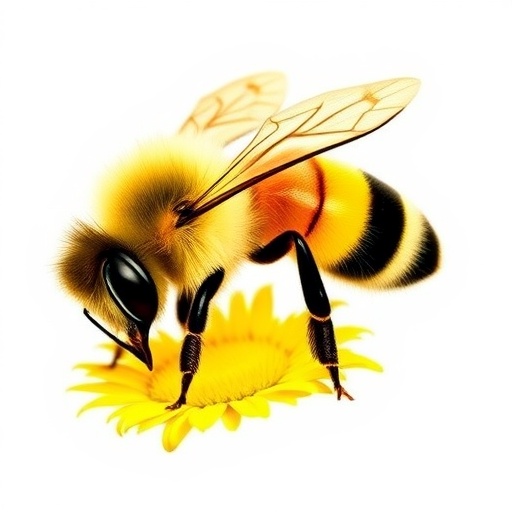The intricate social structure of honey bee colonies has long fascinated scientists, but recent research is shedding new light on the mechanisms behind one of their most dramatic behaviors: stinging for defense. While it is well understood that honey bees fulfill a multitude of roles within the hive—ranging from nectar and water collection to thermoregulation—only a subset engage directly in colony defense by stinging invaders. Now, groundbreaking research from the University of Konstanz delves into the complexities of this defensive behavior, revealing that individual personalities among bees profoundly influence whether or not they decide to sting.
Traditionally, scientists believed that stinging behavior was predominantly dictated by external social cues and pheromones—chemical messages bees release to coordinate collective action. When a bee stings, it emits an alarm pheromone which alerts and recruits other bees to join the attack, increasing aggression until a certain threshold is reached. This feedback loop, regulated by the alarm pheromone concentration, ensures that the colony mobilizes defense effectively while minimizing unnecessary loss, as individual bees sacrifice their own survival by losing their stinger in the act.
One of the pivotal discoveries in this study is the pronounced individuality among bees concerning stinging propensity. Despite the strong social framework of the hive, which emphasizes collective effort and task specialization, it appears that certain bees possess an innate tendency either towards aggression or calmness. The research reveals that even when exposed to identical threats and social environments, some bees reliably stood out as defenders, while others consistently abstained from attacking.
Moreover, the study tested the influence of social factors such as the presence of other guard bees and the concentration of alarm pheromone produced during the stinging process. While these factors did affect bee behavior to some degree, they did not override the individual ‘personality’ trait relating to aggressiveness. This finding undermines earlier assumptions that social conformity governs defensive reactions in honey bees and instead highlights an unexpected level of behavioral individuality within a highly eusocial insect species.
This individuality holds important implications for understanding the collective dynamics of animal groups. In honey bee colonies, where division of labor is usually seen as rigidly task-oriented, the nuanced interplay between individual behavioral tendencies and group coordination adds a layer of sophistication that was previously underestimated. The persistence of individual differences even in strongly social contexts hints at the evolutionary advantages of behavioral diversity within a colony, possibly enabling more flexible and adaptive responses to environmental challenges.
Technically, the methods used by Kannan and her collaborators involved carefully selecting guard bees from the same hive to form experimental groups, thereby controlling for potential confounds like task specialization. This approach was critical to isolating the influence of innate behavioral tendencies from other factors that could influence stinging responses. Using the dummies to provoke stinging also normalized external stimuli across trials, allowing for reliable longitudinal observations.
The study further explored the effect of group size on the likelihood of bees responding to alarm pheromones—a dimension supported by prior research—which found that social context modulates how bees interpret chemical signals. However, individual personality traits proved to be more predictive of whether a bee would join the attack than cues emanating from the surrounding social environment, marking an important contribution to behavioral ecology.
The practical implications of these findings extend beyond academia. Understanding individual variation in defensive behavior could inform approaches to bee management, particularly in apiculture practices where colony defense plays a critical role in hive health and productivity. For example, selecting for colonies with a balanced representation of aggressive and calm individuals might optimize defense without incurring excessive mortality.
Moreover, the findings resonate with wider discussions in behavioral science surrounding personality in animals—a field once thought to be the domain of mammals and birds, but increasingly recognized across insect taxa. The notion that even diminutive organisms such as honey bees possess consistent, identifiable behavioral phenotypes broadens our appreciation of cognition and individuality in nature.
The research also invites further inquiry into the genetic and environmental determinants of these behavioral differences. Do aggressive bees emerge from specific genetic lineages, or are their traits modulated by developmental conditions within the hive? Are there learning or experience effects that reinforce individual tendencies? These questions pave the way for future studies building on this foundational work.
In sum, the University of Konstanz study disrupts conventional views by demonstrating that honey bee defensive behavior, while socially coordinated, is deeply influenced by stable individual traits. Recognizing that personality matters even in the context of eusocial insects demands a reevaluation of how we conceptualize collective behavior and offers exciting avenues for both theoretical and applied science.
Subject of Research: Defensive behavior and individuality in honey bee stinging responses.
Article Title: Consistency and individuality of honeybee stinging behaviour across time and social contexts.
News Publication Date: Not explicitly provided (study published 2025).
Web References:
https://royalsocietypublishing.org/doi/full/10.1098/rsos.241295
References:
Kannan K., Galizia C. G., Nouvian M. (2025) Consistency and individuality of honeybee stinging behaviour across time and social contexts. Royal Society Open Science 12:241295. DOI: 10.1098/rsos.241295
Image Credits: University of Konstanz
Keywords: Honey bee, Defensive behavior, Stinging, Alarm pheromone, Individuality, Behavioral ecology, Eusocial insects, Neurobiology, Collective behavior, Animal personality, Experimentation, Apiculture
Tags: alarm pheromones and bee behaviorbee behavior personality assessmentcolony defense strategies in beesfactors influencing bee aggressionhoney bee colony defense mechanismsimpact of individual bees on colony dynamicsindividual differences in bee personalitiespheromones and bee communicationresearch on honey bee stingingsocial structure of honey bee coloniesstinging behavior in honey beesUniversity of Konstanz bee research





